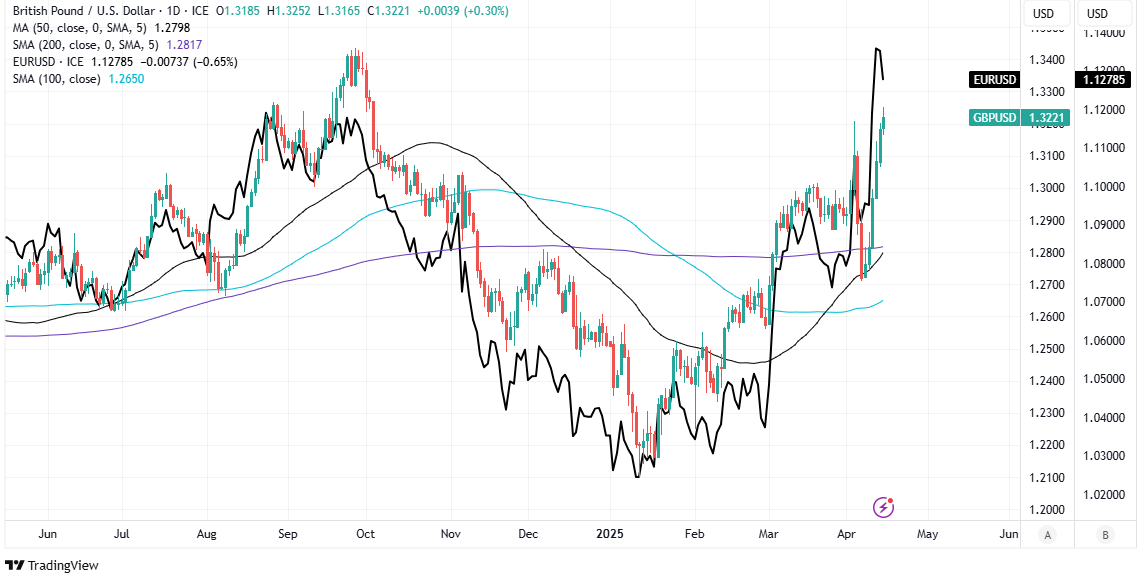
Image © Adobe Images
The Pound to Dollar exchange rate ros to fresh six-month highs on Tuesday, helping GBP/EUR recover further off recent 18-month lows, with some on the sell side citing reported progress in trade talks with the US.
GBP/USD recovered from early losses in the wake of a poor UK employment report and climbed through much of the European morning before peaking at 1.3252 and its best level since the before a rampantly strong US non-farm payrolls report sent the Dollar rallying in early October last year.
GBP/EUR followed along in tow, and later continued higher throughout the day as EUR/USD receded further from the three-year highs reached on Monday, taking other locals with it and lifting the broad Dollar after Beijing sought to enforce its floors or minimum levels in numerous Chinese Renminbi pairs.
“Vance has stated that there is a ‘good chance’ of a trade deal between the US and the UK after Trump stated he was willing to be ‘very flexible’ with tariffs,” says Sarah Ying, head of FX strategy at CIBC Capital Markets.
“The 90-day pause on reciprocal tariffs remain in effect with negotiations ongoing. We speculate that there will not be any big negative tariff announcements in the face of negotiations or continued talks,” she adds.
Above: Pound to Dollar rate shown at daily intervals with GBP/EUR. Click for closer inspection.
Ying also noted that “3m risk reversals (calls – puts) for EUR/USD and GBP/USD have risen to levels not seen post COVID,” which follows other reports of heavy Sterling sales by systematic hedge funds over the last week.
Sterling remained buoyant against the Dollar even as many other currencies turned lower, leading the Pound to rise on the crosses, amid amid an apparent effort by authorities in Beijing to lift the Renminbi off Tuesday’s minimum levels relative to the Norwegian Krone, Swedish Krona, Swiss Franc and South African Rand.
That coincided with the high and beginning of a gradual retreat in EUR/USD as the Pound, Japanese Yen, New Zealand Dollar, Australian Dollar and Mexican Peso remained buoyant enough to retain some intraday gains.
Both AUD/CNY and NZD/CNY later tested their upper limits in early North American trade before retreating in tandem with NZD/USD and AUD/USD amid strong and sustained co-movement between all pairs.
Above: Pound to Dollar rate shown at daily intervals with EUR/USD. Click for closer inspection.
Tuesday's Dollar decline was always going to be limited after Beijing raised the central parity fixes and trading limits for 14 of the 25 currencies and some 49.53% of the China Foreign Exchange Trade System (CFETS) Index, while leaving one unchanged and lowering those for 10 others including the Swedish Krona and Euro.
This followed a broad depreciation signal on Monday in which all 25 Renminbi pairs saw their fixes lowered, and week in which both the Renminbi and Dollar came under pressure against all G10 currencies and some 16 in the broader G20 basket amid an escalation of the trade spat between Washington and Beijing.
The balance of changes on Tuesday perhaps reflects a preference for the trade-weighted currency to stabilise, which would matter for the Dollar because Beijing’s basket-based approach to its managed-floating exchange rate creates a high correlation and quasi peg between the trade-weighted currencies.
"[Treasury Secretary Bessent also] reiterated his administration’s strong-dollar policy and noted he sees no evidence of sovereign sales of Treasuries,” says Dr. Win Thin, head of markets strategy at Brown Brothers Harriman.
"We look for continued dollar weakness and view any dollar recoveries as quite fragile, no matter how the U.S. data come in. Given the ongoing unpredictability of Trump administration policy, we continue to downplay any notions of a Fed response in the near term, which official comments would seem to confirm," he adds.
Above: US Dollar Index at daily intervals with various Renminbi pairs. Click for closer inspection.



